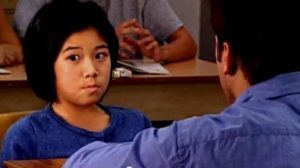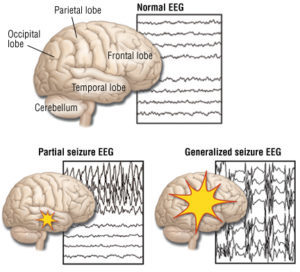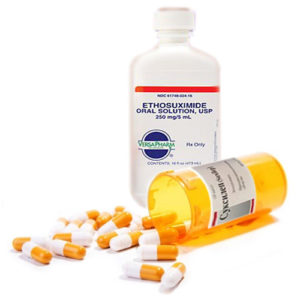
Picture source: Best Online MD
Whether we notice or not, children around us can be found to be distantly adrift in what it seems to be their own world. This condition is assumed to be normal; some children actually do have lack of attention to their surroundings. In school, teachers frequently found students lost in their fantasy and did not pay enough attention in class. When questioned, these children did not respond and kept mum. This phenomenon should not be taken lightly by parents and teachers. Do not assume the children behave as such due to laziness or being tired. A child who is always daydreaming might be experiencing seizures called ‘absence seizures’. Absence seizure is also known as petit mal seizure, usually occurring in children aged between 3 to 15 years old. Children who experience this type of seizure may experience a few attacks in a day without knowing them. This type of seizure is hard to recognise because the symptoms are unclear, only noticed as blank stares.

Picture source: Drugs.com
A seizure is caused by abnormal or excessive brain electrical activities which influences the level of awareness, behaviour and movement. Seizures are divided into partial seizures which involves a part of the brain, either left or right; and generalised seizure which involves the whole brain. The obvious difference between these two is, for partial seizure, the patient is still conscious while in a generalised seizure, the patient experiences loss of consciousness. Absence seizure is classified as a generalised seizure because the patient loses total awareness to his surroundings.
A frequently repeating seizure is known as epilepsy. Not all patients with seizures have epilepsy. Bear in mind not all seizure is accompanied by erratic movements of body parts, spasms or convulsions and frothing mouth but there are many other signs of seizures might be present. Absence seizure might present with the following:
- Frequently having blank stares
- Suddenly falling without any causes
- The eyeball rolls upwards
- Flapping of the eyelids
- Slow brain development and affecting the performance in school
- Headaches
- Emotional distress
- Body cramps
- Convulsions
Parents and teachers should always be on the look-out for children’s behaviour. If they demonstrate any of the list stated above, please refer to a doctor. This is essential to prevent from the possibility of attack from a more serious seizure or other complications. If this condition is not treated, absence seizure can bring more harm to their safety, education performance and their quality of life. This condition can be managed and children can fully recover if they are properly treated. Medications used to control absence seizures are as follow:
Ethosuximide (Zarontin)
This is the first choice of absence seizures. It comes in capsule and syrup form. For children under the age of 6, this medicine is taken in doses 50-100mg per day and can be gradually increased up to the maximum dose of 250mg per day, depending on frequency of attacks.
Side effects: Lethargy, headaches, gastro-intestinal disorder/disturbance, rash
Sodium valproate (Epilim)
This medicine is available in capsule, tablet and syrup form. To be taken in doses 10-15mg/kg per day and can be increased gradually up to the maximum dose 60mg/kg.
Side effects: Liver damage, gastro-intestinal disorder/disturbance and thrombocytopenia
Lamotrigine (Lamictal)
Taken as complement therapy with another medicine. This medicine is in tablet form. Dosage for children under 12 years old is 1.5mg/kg twice daily. Doses can be increased and must not exceed 200mg per day.
Side effects: Rash, diplopia (seeing double), confusion, Stevens-Johnson syndrome (severe skin reaction)
Clonazepam (Rivopam)
This medicine is in tablet form. For children below the age of 12, this medicine is given in doses of 0.5-0.75mg per day.
Side effects: lethargy, muscle weakness, confusion, depression, slurry speech?
 If the children are confirmed to have absence seizures, the parents must ensure that they take the proper medicine with correct doses and note for any side effects emerging due to the medication. Parents must take extra care in terms of safety like having them wear helmets and knee guards while cycling or other activities. This will avoid further injury to the children if they fall down when experiencing seizure attacks.
If the children are confirmed to have absence seizures, the parents must ensure that they take the proper medicine with correct doses and note for any side effects emerging due to the medication. Parents must take extra care in terms of safety like having them wear helmets and knee guards while cycling or other activities. This will avoid further injury to the children if they fall down when experiencing seizure attacks.
These children should not be abstained from activities like swimming. They need to be given freedom to play but must always be under the supervision of adults. They are advised to wear wrist bands or medical bracelets to make sure the people around them know that these children might have seizure attacks at any given time. Other than these precautionary steps, these children must be monitored to have adequate sleeping time, eating a healthy diet and take the necessary medications should they fall ill. Medication is important because there are cases where children had seizures while having fever and according to the parents, they refuse fever medications for fear of side –effects. This is a misconception. Medications is a must and safe if taken following the dose and instruction given.
Last but not least, parents, teachers and the public should be aware of the behaviour of children around them. Do refer to the doctors or health consultants if you suspect anything abnormal in children.
Article by,
Dr Nadia Mohd Effendy,
Pharmacologist and Lecturer in Universiti Sains Islam Malaysia (USIM)
This article was translated from https://www.mmgazette.com/mengelamun-serangan-sawan-absence-seizure-atau-perlakuan-dr-nadia-mohd-effendy/ by Azizul Ismie Mohd Puad.
References:
Consensus Guidelines on the Management of Epilepsy. 2010. Epilepsy Council, Malaysian Society of Neurosciences.
Laura M.G. 2017. Absence epilepsy: Continum of Clinical Presentation and Epogenetics? European Journal of Epilepsy 44: 53-57
Jeffrey R.T & Tracy A.G. 2013. The Current State of Absence Epilepsy: Can We Have Your Attention? Epilepsy Currents 13(3): 135-140.
Absence Seizures. 2017. Epilepsy Foundation of America. url: https://www.epilepsy.com/learn/types-seizures/absence-seizures
Epilepsy Treatment. MIMS Malaysia 2017.
[This article belongs to The Malaysian Medical Gazette. Any republication (online or offline) without written permission from The Malaysian Medical Gazette is prohibited.]
